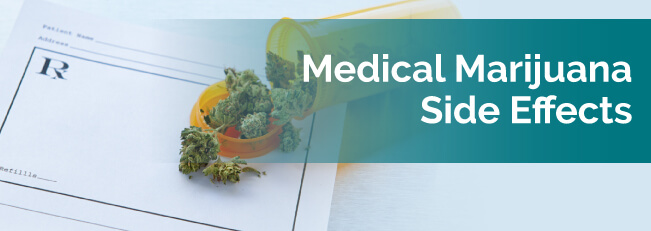
Whether you use cannabis recreationally for its euphoric properties or therapeutically for its medicinal properties, at times, it produces a variety of psychological and physical side effects. Not all people experience the same side effects, and the reaction you get depends on the type and method of marijuana you use. Still, it’s a good idea to learn the potential side effects you may experience with medical marijuana.
Medical cannabis is a flexible medication poised to help you with various side effects of a whole range of medical disorders like glaucoma, cancer, multiple sclerosis, HIV/AIDS and more. But just like other medications, medical weed can cause specific effects.
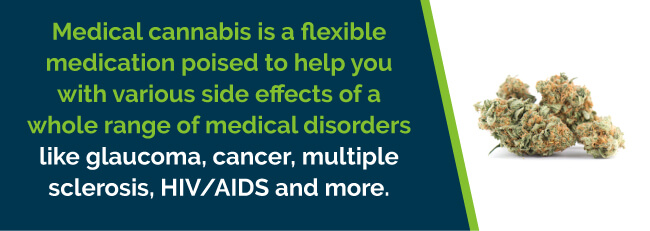
However, the side effects of cannabis are more manageable and much milder than the effects you get from certain prescription medications. Also, with opioids and other pain relievers and narcotics, you risk addiction. Further, there haven’t been any recorded deaths due to cannabis overdose like there have been with thousands of other medications.
Medical pot affects each person differently, but you may experience one or more of the any of these side effects:
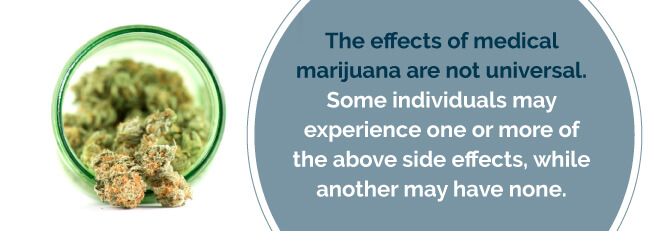
The effects of medical marijuana are not universal. Some individuals may experience one or more of the above side effects, while another may have none. Also, some people may experience side effects not listed above. Some reactions, such as experiencing anxiety, panic or paranoia, are more common if you take too much marijuana or if you are an inexperienced cannabis user.

You can reduce these medical marijuana side effects in many ways. For instance, if you’re experiencing anxiety, you can try medicating in a secure, comfortable environment. There’s also a chance you might be using the wrong strain, so switching strains can eliminate your side effects. You could try using an Indica or hybrid instead of a Sativa strain to see if it helps.
Below, we go over each of the above side effects and offer tips in some cases to reduce or eliminate them.
Although small amounts of THC have been shown to have calming effects and relieve anxiety, larger doses for some cannabis users may bring on mild to intense angst – and even panic. Studies show specific factors increase your risk of experiencing anxiety or paranoia. These factors include:
By using low-THC, high-CBD marijuana strains instead, you can reduce or even prevent an anxiety or paranoia event.
Strong doses of marijuana high in THC can make some people paranoid, yet contrary to popular belief, not every marijuana episode automatically produces paranoia. If you become paranoid after using marijuana, do your best to remain calm. The feelings will subside. Consider playing relaxing music, and if you’re overly paranoid, try taking a warm bath or shower. You can also try switching to strains low in THC, like ACDC, Strawberry Dream, Key Lime Pie and Golden Ticket.
You can develop what is known as “cotton mouth” as one of the side effects of medical marijuana. You may also be incredibly thirsty. If this happens to you, try drinking water before you use marijuana. Then, continue drinking some water while treating and after you’ve finished dosing. Some cannabis users alleviate their dry mouth by chewing gum.
For a more significant relief from cotton mouth, use a demulcent, which is a substance designed for oral use that provides a wet coating or film over your mucus membranes.
While not everyone experiences ceaseless hunger when using medical weed, when using cannabis, chances are you’ll get the “munchies.” Therefore, if you want to avoid gaining weight when using the herb, plan out a few strategies first to conquer hunger. For instance, plan your meals for the day in advance – and stick with this plan. When you don’t have anything else to eat, brush your teeth. Brushing your teeth helps you stop eating when you have the intention of stopping.
Even though weed is known more for producing sedative effects, if you find yourself struggling with insomnia after using, there are some things you can try, such as:
Cannabis dilates blood vessels, including those in your eyes, which causes your eyes to be red and bloodshot. Like combating dry mouth, you need to stay hydrated to keep your eyes from drying out and becoming irritated and red. You could also use natural tear eyedrops to lubricate your eyes and wear sunglasses to conceal your red eyes.

There’s no doubt marijuana affects your memory, hence the explanation of why people lose their train of thought in mid-conversation when under the influence of weed. And research suggests a link between cannabis use and a reduction in verbal, short-term memory.
In chronic users, the herb may have a lasting impact on their memory. Heavy users have more potential of forgetting words they just read than non-users. Here are some things you can do if you have a short-term memory impact when you take marijuana.
Some marijuana users enjoy heightened sensory experiences as one of the side effects of medical cannabis. For example, they see colors more vibrantly and hear sounds more individually. They may also experience an altered perception of time.
There are ways to get around these two side effects of medical weed, including:
Smoking cannabis may cause some of the same respiratory issues tobacco smokers experience, such as having phlegm production and a daily cough. They may also get acute chest illnesses, such as bronchitis, more frequently, according to the National Institute on Drug Abuse. The easy solution to this is to try a different method of use. You have a lot of options available for consuming your medical cannabis, including:
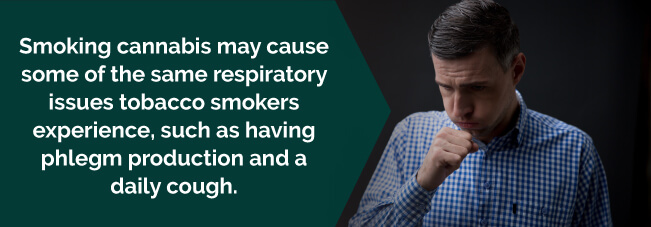
We’ll provide more information on methods of use a little further down this article.
Some people experience a sense of giddiness after using marijuana. They may giggle or laugh about trivial things. If you see you’re especially giddy after taking marijuana and this feels unpleasant to you, you may need to select a strain with no, or very little, THC content.
When you do drugs regularly, you can build up a tolerance. As your body adjusts to any drug, over time, it becomes less effective. Although your brain comprises many cannabinoid receptors, and it can take quite some time to develop a tolerance to cannabis, it can happen. You’ll need to know how to control it.
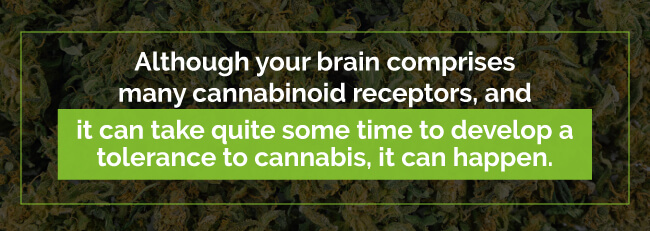
Try switching between strains. There are two major types: Sativa and Indica. Switching between the two can help you avoid a tolerance to either of them. Though you may prefer one over the other, if you don’t care about the differences, swapping can help build your tolerance level more gradually.
Marijuana engages your cells through its chemical compounds. This engagement produces weed’s sedative effects. There are a couple of reasons medical marijuana can make you tired.
Managing medical pot-related fatigue could be as easy as switching to a different strain.
According to the National Institute on Drug Abuse, cannabis significantly impairs reaction time, motor coordination and driving ability. The agency reports that studies have revealed a direct relationship between THC concentration in a person’s blood and their driving ability.
Medical marijuana can both cause and help diarrhea and constipation.
CBD strains may cause diarrhea.The compound CBD regulates your body’s endocannabinoid system (ECS). While it’s good for putting functions back in place when they go out of line, CBD may also cause loose stools. When CBD causes diarrhea, this could be due to either your tolerance capability or dose dependence.
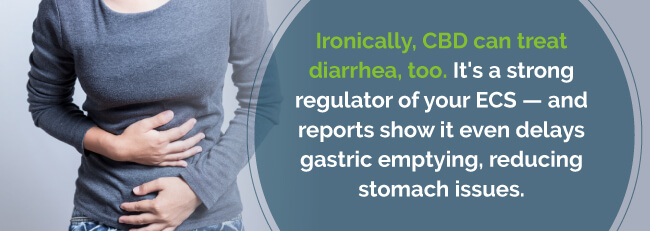
Ironically, CBD can treat diarrhea, too. It’s a strong regulator of your ECS – and reports show it even delays gastric emptying, reducing stomach issues such as:
As CBD binds to certain receptors in your intestines, the cannabinoid helps with pain reduction, muscle relaxation, inflammatory action reduction and diarrhea-causing spasms.
If you continue suffering from constipation when using CBD, it’s better to reduce your dose and consult with your physician. You may want to include some natural ways of relieving your bound bowels, such as drinking lots of water and eating a diet high in fiber.
Your heart rate can increase by up to 100 percent for up to three hours after taking medical marijuana. This rapid heart rate is known as tachycardia. Along with this, you have an increased risk of a having a heart attack for the first 60 minutes after taking marijuana.

Medical weed may also throw your balance off, since it influences two areas in your brain that help regulate balance, reaction time, posture and coordination: basal ganglia and cerebellum activity.
Keep this in mind when you are using your cannabis treatment and ensure you are in a safe and comfortable environment, preferably sitting or lying down. Try lower doses to determine if it helps.
The National Institute on Drug Abuse reports some individuals may experience hallucinations, delusions, loss of personal identity and acute psychosis when taking large amounts of marijuana. These reactions are temporary and are more likely to occur in vulnerable individuals.
The higher the dose of marijuana you use, the more chances you have of feeling lightheaded – sometimes to a point where you feel like you’re going to faint. Fainting is rare, but may be more probable if you’re using methods like high-potency dabbing, which can produce much stronger effects than other methods of marijuana.
With dabs, some users’ cannabinoid receptors are rapidly saturated, giving them an intense “rush.” A sudden drop in blood pressure can cause your blood vessels to dilate, making you feel faint.
This phenomenon may have cofactors, which may include:
Chronic heavy marijuana users reduce their cannabinoid receptor concentration naturally, likely making them less susceptible to fainting.
Marijuana can produce dizziness upon standing. In a small study of 10 people, those who experienced severe dizziness had marked reductions in blood pressure.
Individuals who take cannabis – mainly between 30 and 39 years old – who also take the drug Ativan to manage depression may have urinary retention as a side effect of ingesting the herb. On the flip side, in a 2013 study published in the journal Gynecology & Obstetrics, researchers found subjects experienced a 25 percent improvement in urinary incontinence after having been administered marijuana extracts with THC.
As a result of muscle weakness induced by marijuana, cannabis users may sometimes experience difficulty speaking and slurred speech. Researchers at the University of Cadiz found cannabinoids hamper the ability of neurons, which are charged with muscle orders, to transmit information. The scientists say this phenomenon also explains why individuals with neurodegenerative diseases, like multiple sclerosis, find symptom relief after taking marijuana.
Though cannabis rarely causes physical dependence, there is the chance of psychological dependency. Like with tolerance, taking breaks is essential and effective. Take a break every fourth week or in accordance with your doctor’s recommendations, substituting your cannabis treatment with a different pain reliever. Or, if you use the treatment for depression, for instance, during your breaks, convince yourself you don’t need the herb to feel happy.
If you’re having side effect issues, you can try various tips to minimize or eliminate them. For instance, you should:
Several other tips can help you minimize or avoid medical marijuana side effects.
The main effect people are drawn to when taking marijuana is the euphoric high they get from the psychoactive response of THC. After entering your bloodstream, the mind-altering cannabinoid THC eventually engages with your brain’s cell receptors.
Many individuals use cannabis for recreational purposes because they desire the high THC provides. But this high often comes with other related effects. The amount of medical weed you consume determines how long these effects take to develop. When you smoke or vape cannabis, your body absorbs the THC faster than if you take it orally and your stomach has to digest it first.
Because of these possible side effects, you may want to plan when you use your THC-containing marijuana treatment – for example, wait several hours before you get behind the wheel of a vehicle. The effects typically take three to four hours to wear off, depending on the method of marijuana ingestion you used. The effects of edibles can last longer.
Now, you don’t necessarily have to get a strain high in THC. In fact, many people don’t like the buzz THC causes. If you’re looking for the therapeutic benefits of medical marijuana, but don’t want the psychoactive effects, you can try a strain higher in CBD instead of THC. The cannabinoid CBD isn’t psychoactive, but still provides therapeutic effects.
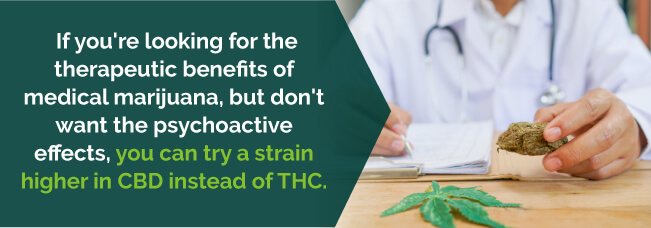
You can choose from a variety of different high-CBD and low-THC strains. Indica strains are high in THC, so you’ll probably want to avoid those if you don’t want the high that goes along with the benefits. Go for a Sativa, which is usually high in CBD, or even a hybrid strain, where there’s a balance between the two. Work with your local dispensary budtender to choose the strain right for you.
Know and understand there are three main types of marijuana strains.
If you’re experiencing fatigue as a side effect of medical marijuana, for example, several strains could be making you tired. You may not want to use specific strains if you’re trying to combat fatigue. These include:
However, you could try these energizing strains to help you stay awake:
You may want to try one of the sleep-inducing strains at nighttime to ensure you get a good night’s sleep and feel more alert the next day.
Marijuana’s medicinal benefits are only as good as the materials used to grow the plants. Before you use medical marijuana, it’s a good idea to conduct research first. Not all marijuana products are created equal. If you can, try starting with organic products for optimum benefit.
Some safety concerns you’ll need to be aware of are pathogens, mold and other harmful additives. The best way to protect yourself against mildews and molds is to either grow your medical marijuana yourself or opt for laboratory-tested weed. You’ll learn about mold control mechanisms by researching your grower or looking at a designated grower’s grow room.
Prepared products, like concentrated oils and vapor pens, could contain additives, so learn about the different safe products available and the ones you should avoid.
When you’re ready to start your treatment, you’ll want to gradually work your way up to a stronger, more therapeutic dose over time. Based on your specific condition, your marijuana doctor may give you some pointers. But, since medical marijuana is still labeled as an alternative treatment, many health care providers are either not educated on it or don’t offer their patients comprehensive directions.

Some mild doses you may want to consider include:
For those with severe medical conditions, these smaller doses may not be beneficial. These are starting points, however, and are standard for both medical and recreational marijuana users. Cancer patients may want to work up to a full gram each day of cannabis oil. And, under the supervision of a savvy doctor, the higher the dose, the more therapeutic it is.
The method you choose to use impacts the side effects you experience with medical marijuana.
Dabbing: As we mentioned earlier, dabbing provides much stronger effects. Dabs are THC-rich resins extracted from the cannabis plant you smoke. There are several forms of these extracts, including:
When you smoke cannabis, the THC rapidly passes from your lungs and into your blood. Your blood then carries the chemical throughout your body to your brain and other organs.
When dabbing, you need to be extra-careful in your dosage, since this method can deliver large THC amounts to your body. Also, preparing dabs typically involves using lighter fluid – therefore, if you’re making it, you need to take precautions.
Edibles: Don’t think there are less pronounced side effects with edibles. Sure, your body does absorb THC more slowly when you consume edibles than if you were to smoke it. You’ll typically feel the effects of edibles in around an hour, depending on what you’ve had in your stomach already.
However, the amount of cannabis in edibles can vary. Eating cannabis can produce a stronger effect, too – and it lasts longer than when you smoke it. For new, inexperienced users, the effects may be overpowering. Therefore, save the edibles for when you’ve graduated to an experienced marijuana user.
When you’re first starting out with medical weed treatment, the effects may be intense, especially with edibles. New edible users should start with small doses.
A great way to gauge how well your cannabis treatment is working is to keep diligent notes. You’ll also be able to note the side effects so you can share them with your physician, who can help tailor your medical pot therapy better. Things you’re going to want to write down include:
The Timing of Doses: Take your first 4-6 mg dose in the early evening around 7 p.m. before a day off or when you don’t have anything going on the next day. Have a cannabis-tolerant or sober friend stay with you while you try your first treatment, so they can help you through the effects. By doing this, you can see how the treatment affects you when you know you don’t have any obligations the next day.
If you find it hard to “turn off” your brain after you medicate, you might just need a little fresh air. Get out and walk or jog around the block, as this may help you feel invigorated. Be sure to stay close to your familiar surroundings, and don’t go out if you’re feeling light-headed.
If your condition doesn’t allow you to get outside and walk around the block, find a calm place where you can rest for a little while. Whatever discomfort you may be experiencing will soon pass, so try and remember not to panic if you’re experiencing medical cannabis side effects. If, however, you still can’t shake your discomfort and you’re starting to get worried, you can always seek medical help.
This information is for educational purposes only and isn’t provided by medical professionals. It’s not intended to contradict or replace any medical or health information or advice your doctor provides. It’s only meant to complement your current medical treatment plan. Consult with your physician or another health care provider if you have questions.
Ask your doctor which medical marijuana strain is best for your medical condition. If you’re in need of a quality medical marijuana doctor or a medical marijuana card, or would like to get medical marijuana in your state, MarijuanaDoctors.com can help. We have licensed doctors in all medical marijuana states. Search for a medical marijuana doctor and book an appointment today!

Finally, a helpful & informative website! MarijuanaDoctors.com answered all of my medical marijuana questions and helped me schedule an appointment with an accredited doctor in my area.~Susan - Denver, CO